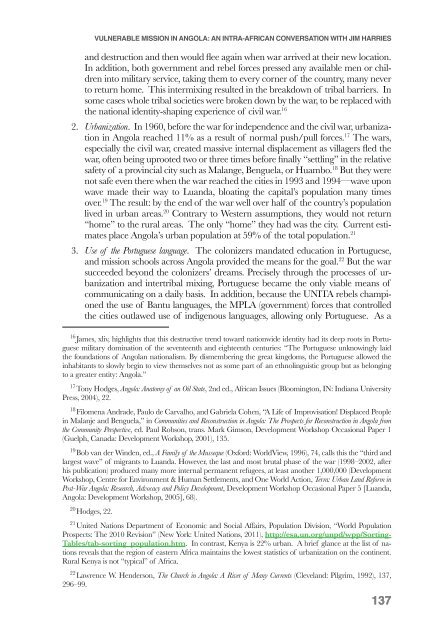VULNERABLE MISSION
VULNERABLE MISSION
VULNERABLE MISSION
You also want an ePaper? Increase the reach of your titles
YUMPU automatically turns print PDFs into web optimized ePapers that Google loves.
<strong>VULNERABLE</strong> <strong>MISSION</strong> IN ANGOLA: AN INTRA-AFRICAN CONVERSATION WITH JIM HARRIES<br />
and destruction and then would flee again when war arrived at their new location.<br />
In addition, both government and rebel forces pressed any available men or children<br />
into military service, taking them to every corner of the country, many never<br />
to return home. This intermixing resulted in the breakdown of tribal barriers. In<br />
some cases whole tribal societies were broken down by the war, to be replaced with<br />
the national identity-shaping experience of civil war. 16<br />
2. Urbanization. In 1960, before the war for independence and the civil war, urbanization<br />
in Angola reached 11% as a result of normal push/pull forces. 17 The wars,<br />
especially the civil war, created massive internal displacement as villagers fled the<br />
war, often being uprooted two or three times before finally “settling” in the relative<br />
safety of a provincial city such as Malange, Benguela, or Huambo. 18 But they were<br />
not safe even there when the war reached the cities in 1993 and 1994—wave upon<br />
wave made their way to Luanda, bloating the capital’s population many times<br />
over. 19 The result: by the end of the war well over half of the country’s population<br />
lived in urban areas. 20 Contrary to Western assumptions, they would not return<br />
“home” to the rural areas. The only “home” they had was the city. Current estimates<br />
place Angola’s urban population at 59% of the total population. 21<br />
3. Use of the Portuguese language. The colonizers mandated education in Portuguese,<br />
and mission schools across Angola provided the means for the goal. 22 But the war<br />
succeeded beyond the colonizers’ dreams. Precisely through the processes of urbanization<br />
and intertribal mixing, Portuguese became the only viable means of<br />
communicating on a daily basis. In addition, because the UNITA rebels championed<br />
the use of Bantu languages, the MPLA (government) forces that controlled<br />
the cities outlawed use of indigenous languages, allowing only Portuguese. As a<br />
16 James, xliv, highlights that this destructive trend toward nationwide identity had its deep roots in Portuguese<br />
military domination of the seventeenth and eighteenth centuries: “The Portuguese unknowingly laid<br />
the foundations of Angolan nationalism. By dismembering the great kingdoms, the Portuguese allowed the<br />
inhabitants to slowly begin to view themselves not as some part of an ethnolinguistic group but as belonging<br />
to a greater entity: Angola.”<br />
17 Tony Hodges, Angola: Anatomy of an Oil State, 2nd ed., African Issues (Bloomington, IN: Indiana University<br />
Press, 2004), 22.<br />
18 Filomena Andrade, Paulo de Carvalho, and Gabriela Cohen, “A Life of Improvisation! Displaced People<br />
in Malanje and Benguela,” in Communities and Reconstruction in Angola: The Prospects for Reconstruction in Angola from<br />
the Community Perspective, ed. Paul Robson, trans. Mark Gimson, Development Workshop Occasional Paper 1<br />
(Guelph, Canada: Development Workshop, 2001), 135.<br />
19 Bob van der Winden, ed., A Family of the Musseque (Oxford: WorldView, 1996), 74, calls this the “third and<br />
largest wave” of migrants to Luanda. However, the last and most brutal phase of the war (1998–2002, after<br />
his publication) produced many more internal permanent refugees, at least another 1,000,000 (Development<br />
Workshop, Centre for Environment & Human Settlements, and One World Action, Terra: Urban Land Reform in<br />
Post-War Angola: Research, Advocacy and Policy Development, Development Workshop Occasional Paper 5 [Luanda,<br />
Angola: Development Workshop, 2005], 68).<br />
20 Hodges, 22.<br />
21 United Nations Department of Economic and Social Affairs, Population Division, “World Population<br />
Prospects: The 2010 Revision” (New York: United Nations, 2011), http://esa.un.org/unpd/wpp/Sorting-<br />
Tables/tab-sorting_population.htm. In contrast, Kenya is 22% urban. A brief glance at the list of nations<br />
reveals that the region of eastern Africa maintains the lowest statistics of urbanization on the continent.<br />
Rural Kenya is not “typical” of Africa.<br />
22 Lawrence W. Henderson, The Church in Angola: A River of Many Currents (Cleveland: Pilgrim, 1992), 137,<br />
296–99.<br />
137


